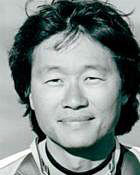 I AM VERY PROUD to have been a part of a project that involved 53 other individuals who dared to do something extraordinarily new. While the event might have been the vision of one man, it took 54 believers to take the Trans Atlantic Windsurf Race into reality.
I AM VERY PROUD to have been a part of a project that involved 53 other individuals who dared to do something extraordinarily new. While the event might have been the vision of one man, it took 54 believers to take the Trans Atlantic Windsurf Race into reality.
Now that we are back on terra firma, it’s easy to sit back and glorify a conquest on the high seas. The trials and tribulations of the trip have all been elevated into nostalgic moments of thrills, spills and chills. At the end, none of the participants I’ve spoken to wanted to leave the mother ship. We’ve all struggled with a post Atlantic syndrome—a lethargic condition that makes everything seem so ordinary.
It was indeed an ultimate windsurfing experience. During the trip, someone asked me what I thought the biggest challenge was. The answer: “To follow a vision to the end.” For no matter how great the original vision might be—the chase, the implementation and the fulfillment of that dream—are to me, the real challenge of a bright idea. These dream-quest aspects of our lives are the gifts of free choice. They empower us, define our existence and in time make up our destiny.
The organizational nightmares of the Trans-Atlantic project made it ripe for failure at every juncture. It was, as one of my colleagues said, “A deeply flawed venture that proved worthwhile.” To me, it was a microcosm of life—flawed, complex, filled with overwhelming obstacles and ever changing moods. It was a bouillabaisse of problems that multiplied with each solution. Every possible stumbling block, including airline strikes, airplane crashes, overloaded buses and tight ferry schedules were thrown at us before we even got to the starting line.
Some would say we were very lucky. Some would say we were blessed. Whatever the case may be, the vision-quest of the Trans Atlantic Windsurf Race was not merely a windy waltz across the ocean, but a demanding dance of faith that only in the end, saw the light of fulfilment. It was an uplifting partnership of human flaws and Divine Good Fortunes.
So I sit quietly thinking about what we have achieved. I see the contradiction of a world that applauds visionaries while simultaneously discouraging free thinking, risk taking and the simple ability to say “Why not!?”
The Trans-Atlantic Windsurfing Race took three years in the making and even at the end, there was no real industry support for the project. In fact, some windsurfing industry leaders banded together to distance themselves because of the risk factor of the endeavor. In their judgement, the event had too many unknowns and too great a possibility of failure.
Advertisement
As the industry sat on the sidelines, the idea of a windsurfing race across the Atlantic, and the risk of failure captivated the world press. Those of us complaining about how windsurfing exists in anonymity didn’t have long to wait before the phone started to ring from CNN, CBS, ABC, NBC, ESPN etc. We had the world knocking down the door but didn’t have our house in order.
It is in our nature to have a hard time with the unknown. Especially with ideas beyond our scope or anyone swimming against the stream of consensus. We are programmed to be defensive to anything new. Anything that challenges the boundaries of our known world is a risk, which is a threat. The creative thinkers are often dismissed as dreamers out of touch with reality. Even the dictionary defines visionaries as 1. One who has visions; a seer; prophet. 2. One who is given to impractical or speculative ideas; a dreamer.
But we are windsurfers! We are the free thinkers who are determined to walk on water. Will we succumb to be snug and content? Will we buy into the illusion of security and develop a fear for failure? Will we become windsurfers who are afraid to get—wet?
From those of us returning from TransAtlantic Windsurf Race, the answer is a resounding . . . NO!
— John Chao
Publisher/Editor

